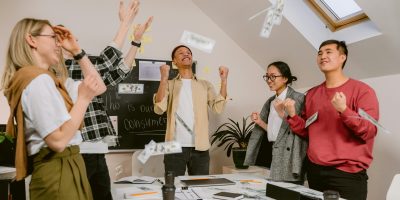“FernUni für alle” is more than a mere catchphrase associated with the university. It is a driving mantra for the university’s instructional designers and educational technologists. Much work is put into continuously improving the accessibility of learning materials to cater to students with particular needs. One such division is that handling both software and books for the visually impaired. Media specialist Tobias Fechner of the Centre for Learning and Innovation (ZLI) spoke to Rahel Papatheodorou about his pathway to the FernUni, his day-to-day work and his love of the English language.
What’s your academic background?
I initially studied IT; then I tried English and Music. Ultimately, I decided to become an audio technician. For someone who is blind studying is always a challenge, and the university I went to before did not have much experience with providing for blind students.
I joined the FernUniversität in May 2022. Before that, I worked at the job centre in Hagen. At some point I came across a vacancy announcement on the FernUni website. They were looking for someone to join the service centre, and I figured I’d toss my hat in the ring. I got the job, but it was a bit of a problem in that I couldn’t support callers adequately due to my blindness. Now I’m working at the ZLI in the section for accessible media, and I love it. This is where I can help.
So what do you do, exactly?
I help to create learning material which is accessible for the visually impaired and the deaf. This entails creating subtitles for videos, writing up material printed in Braille (the tactile script for the blind) and checking DAISY audio recordings for mistakes.
Daisy? Like the flower?
DAISY is basically an MP3 in which you can work with hierarchical structures. Take, for instance, a standard issue course pack (Studienbrief). With DAISY it can be treated like a book. You can command it to go to a particular chapter so that you can listen to that specific chapter. We also have tactile graphics that work with the temperature of the paper, making these pictures perceptible. So, you can discover the graphic with your fingers, as it were.
You learnt Braille; you revise learning materials and you also speak English really well. How did this come about?
Oh, I just love talking in English! I love languages. Originally, I just wanted to learn English in order to understand my computer, you know? When my computer said something, I wanted to know what it wanted from me. But then I had a really good native speaker as a teacher at an English school for the blind and started talking and talking.
Your first language is German, so I take it that’s the main language you use in your work. Is Braille different in English?”
Braille is different in every language. There’s something like basic Braille but also something we call contractions, like one letter for a whole word. So, every language has its own ‘Contraction’ Braille.
I simply have to ask: English orthography can be an absolute nightmare! Does the spelling differ from the pronunciation so much in Braille, too?
Well I would say we have the same difficulty. When you learn a language, you learn it uncontracted at first, so the pronunciation poses the same problem for us, too.
Wow! I truly admire your English skills even more. Spelling is challenging enough. How much harder it must be if you have never so much as seen the words! The motivation you had to learn English is an example for us all.
The studyFIT English Learning Support service is still in its pilot phase. What advice might you offer to improve and adapt online courses? For example, what is the most important thing to consider when developing these Moodle courses?
Moodle is sometimes inaccessible, so when there is new material created, someone needs to inspect it. In my section, my colleague Nathalie Sorichter and I run accessibility tests for various applications, websites and such. For example, if there are embedded videos we’ll check whether the website works with screen readers and programs that transcribe text to speech. Sometimes we consult the department that deals with instructional materials. (Dezernat 5.1).
To learn more about the sterling work being done to make learning materials available to more students, click here to visit the Audio-Tactile Media section’s website.





Leave a Reply